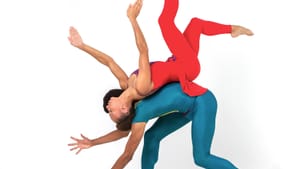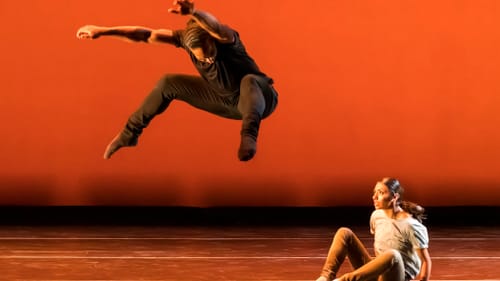Stay in the Loop
BSR publishes on a weekly schedule, with an email newsletter every Wednesday and Thursday morning. There’s no paywall, and subscribing is always free.
Four on the floor
Kimmel Center and Philadanco present 'Choreographers on the Move'

Philadanco’s Choreographers on the Move presented work by two of the company’s most beloved choreographers: Milton Myers and Christopher L. Huggins. By pairing an earlier work with a world premiere by each, company founder and director Joan Myers Brown asks whether, in an age of television dance-competition shows, they are “still true to their aesthetic or are they moving forward being greatly influenced by what [are] deemed the new trends in dance?”
As a fan of the So You Think You Can Dance (SYTYCD) competition since its first season in 2005, I felt the question was worth answering. SYTYCD draws from a wide range of dance styles to find and develop young hopefuls for careers in dance.
More important for our question, the show highlights short choreographic works by the competitors. Dancers’ fortunes can rise or fall on these 90-second pieces. But have they influenced other choreographers?
A case for Milton Myers
Myers opened the evening with his 1986 “Pacing,” an eclectic piece in four parts set to the music of Cameroonian composer Francis Bebey. Part II, for the company’s six men, was a highlight, particularly in its use of shoulders and arm positions, which at times seemed to represent the cartouches of an Egyptian stele. Meyers didn’t forget the fast-moving feet, but even in the floorwork, arms dominated.
Part IV brought the company together with men on one side in costume designer Jolea Maffei’s blue jumpsuits and women on the other in pink tights and short skirts (the skirts read as orange in William H. Grant’s lighting). The dancing was energetic and the work coalesced as a striking visual experience.
By contrast, Myers’s new work, “Waves,” fell short. The piece, with an original score by John Levis, focused on the four women’s solos, performed in Myers’s designs: short white dresses, in front of a screen like a Rothko painting that changed colors for each woman.
At a post-show discussion, dancer Joe Gonzales said the company’s men secretly recast the parts for themselves, which made sense. Each solo felt like an audition piece, emphasizing the dancer’s technique, strength, and power.
{photo_2}
But “Waves” lacked a center. If this piece was not influenced by the competitions on TV, it certainly shares in some of its aesthetics.
Christopher L Huggins, then and now
Huggins’s 2013 “When Dawn Comes” told the story of a woman’s journey. It began with four women in short white dresses (designed by Huggins). They woke, it seemed, from a dream (to an original score by Jeff Story and Rachel Grimes). The men walked by and the women followed, except for Rosita Adamo, who leaped onto Joe Gonzales, wrapping her legs around his waist.
The dance charted the path of a relationship, from ecstasy to disappointment. Adamo lifted Gonzales, turned in a circle carrying him, then dropped him in disgust, but the push and pull of the relationship continued until Gonzales walked away. At first Adamo seemed devastated, but in moments her head was up, shoulders back, and she sashayed offstage unbowed.
I thought this would be the evening’s highlight, but Huggins’s “I Come as One, But Stand as 10,000” surpassed the others with a shattering performance. The title of Huggins’s new piece refers to a line in Maya Angelou’s poem “Our Grandmothers,” about grandmothers who stood strong in the face of slavery’s horrors.

Movement I opened with a single woman in a square of light on an otherwise darkened stage. When the lights rose, more dancers joined her. The sound of their breathing, visually emphasized by abdominal contractions, added a percussive element to the score (original music by Darryl J. Hoffman with additional music by Cinematic Orchestra and Sons of Kemet).
Movement II, “No Means No,” was wrenching. In it, Rosita Adamo struggled to escape four male dancers. As they lifted her over their heads she beat her fists and kicked into the air, seeming to escape, only to have them drag her back again. In the pause between movements, my companion leaned over and whispered, “That reminds me of Christine Blasey Ford.”
We were thinking of the professor’s sexual-assault testimony against Brett Kavanaugh, then a Supreme Court nominee; Huggins had been thinking the same thing, and said so after the performance. Movement III, “The Protest,” ended with the company in full hip-hop dance-battle mode. It was glorious.
Huggins showed us that in talented hands, dance can communicate the human cost of oppression and the resilience of its opposition.
What, When, Where
Choreographers on the Move. "Pacing," and "Waves," choreography by Milton Myers; "When Dawn Comes," and "I Come as One, but Stand as 10,000," choreography by Christopher L. Huggins. Philadanco. November 16-18, 2018, at the Kimmel Center's Perelman Theater, 300 South Broad Street, Philadelphia. (215) 893-1999 or philadanco.org.
Sign up for our newsletter
All of the week's new articles, all in one place. Sign up for the free weekly BSR newsletters, and don't miss a conversation.

 Camille Bacon-Smith
Camille Bacon-Smith